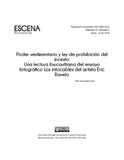Mostrar el registro sencillo del ítem
Poder vestimentario y ley de prohibición del incesto: una lectura foucaultiana del ensayo fotográfico Los intocables del artista Eric Ravelo
| dc.creator | Schroeder Leiva, Kira | |
| dc.date.accessioned | 2021-07-19T15:00:30Z | |
| dc.date.available | 2021-07-19T15:00:30Z | |
| dc.date.issued | 2016-07 | |
| dc.identifier.citation | https://revistas.ucr.ac.cr/index.php/escena/article/view/25577 | |
| dc.identifier.issn | 1409-2522 | |
| dc.identifier.uri | https://hdl.handle.net/10669/83931 | |
| dc.description.abstract | Este ensayo es una lectura del proyecto fotográfico Los intocables del artista cubano Eric Ravelo que muestra cuerpos, cuerpos adultos y cuerpos niños, con una particular forma de relacionarse que se nos hace evidente a través de la posición en que se presentan los cuerpos y la forma en que estos cuerpos están ataviados. Estas características exponen ciertas relaciones de poder –poder vestimentario– que ordena los cuerpos y las relaciones entre ellos. En este ensayo se propone que los núcleos de poder-saber evidenciados por Ravelo en su proyecto fotográfico, articulados por el artista como relaciones sacrificiales ordenadas por una cierta forma de vestir los cuerpos, vislumbra una grilla de inteligibilidad donde los núcleos de poder producen espacios de excepción a la ley de prohibición del incesto. Además, argumenta que esta forma de develamiento crítico a través del arte que realiza Ravelo puede pensarse como un acto de un parrhesiasta tal y como lo trabaja Foucault en su libro El coraje de la verdad, entendido como un forma de enunciación de verdad en un acto creador. | es_ES |
| dc.description.abstract | This essay is a reading of the photographic project The untouchables created by the Cuban artist Eric Ravelo which shows bodies, adult bodies and child bodies, with a particular way of relating to each other, that is shown to the observer through the position in which the bodies are presented and the way the bodies are dressed. These characteristics show a certain set of power relations, dress power that arranges the bodies and the relations among them. The author proposes that the power-knowledge nuclei evidenced through Ravelo’s photographic project, articulated by the artist as sacrificial relationships given by a certain way in which the bodies are dressed, brings to light an intelligibility grid where the power nuclei produces spaces of exception of the incest prohibition law. Furthermore, the author argues that this form of critical unveiling through art that Ravelo carries out can be thought of as an act of a parrhesiasta, concept developed by Foucault in his book The courage of truth. | es_ES |
| dc.language.iso | spa | es_ES |
| dc.source | ESCENA. Revista de las artes, vol.75(2), pp.41-60 | es_ES |
| dc.subject | Arte crítico | es_ES |
| dc.subject | Foucault | es_ES |
| dc.subject | Ravelo | es_ES |
| dc.subject | Poder vestimentario | es_ES |
| dc.subject | Critical art | es_ES |
| dc.subject | Dress power | es_ES |
| dc.title | Poder vestimentario y ley de prohibición del incesto: una lectura foucaultiana del ensayo fotográfico Los intocables del artista Eric Ravelo | es_ES |
| dc.type | artículo original | |
| dc.identifier.doi | 10.15517/es.v75i2.25577 | |
| dc.description.procedence | UCR::Vicerrectoría de Investigación::Unidades de Investigación::Artes y Letras::Instituto de Investigaciones en Arte (IIArte) | es_ES |
Ficheros en el ítem
Este ítem aparece en la(s) siguiente(s) colección(ones)
-
Artes plásticas [194]
-
Escena 75(2) [18]


